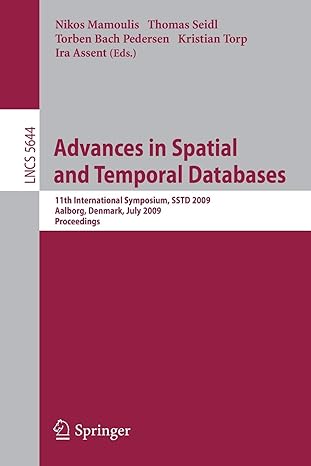Answered step by step
Verified Expert Solution
Question
1 Approved Answer
Need the answer in Java Language!!! Programming Project-3 In this project you will write a program that perform certain financial calculations. The financial calculations should


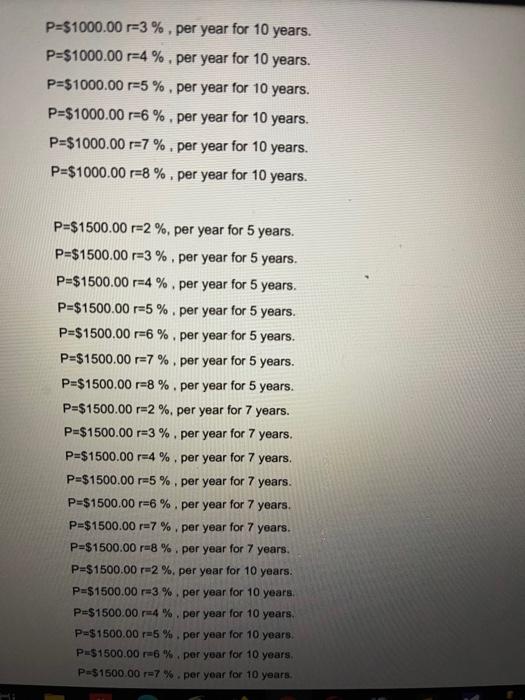
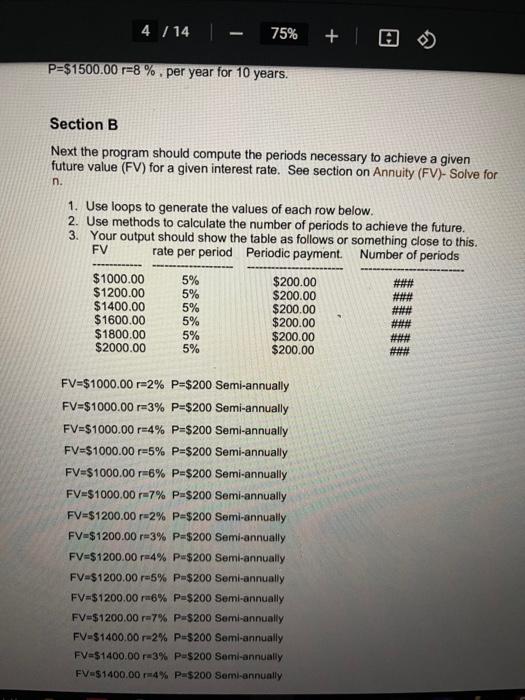
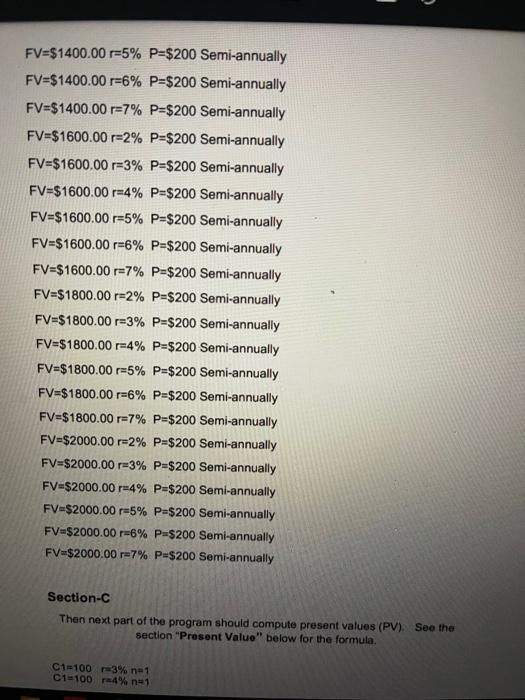
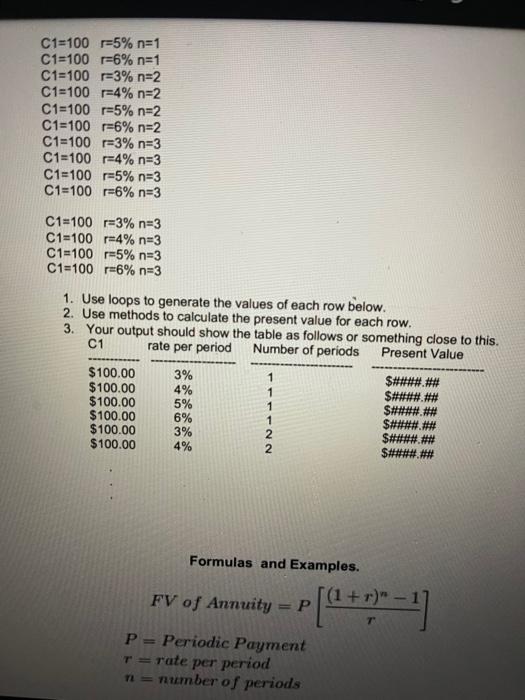
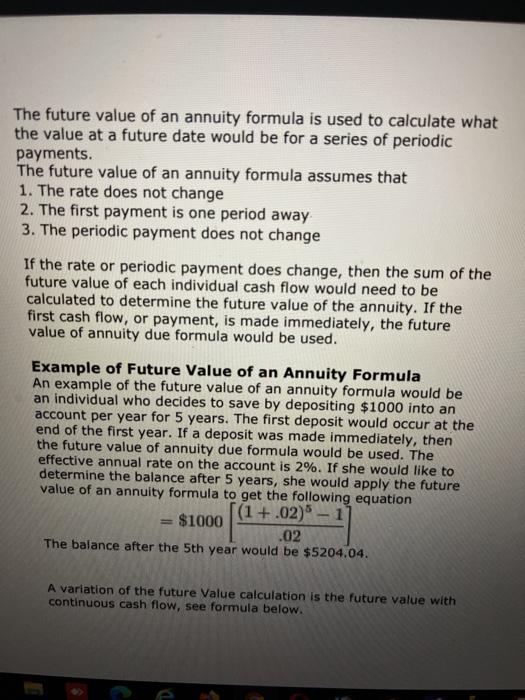
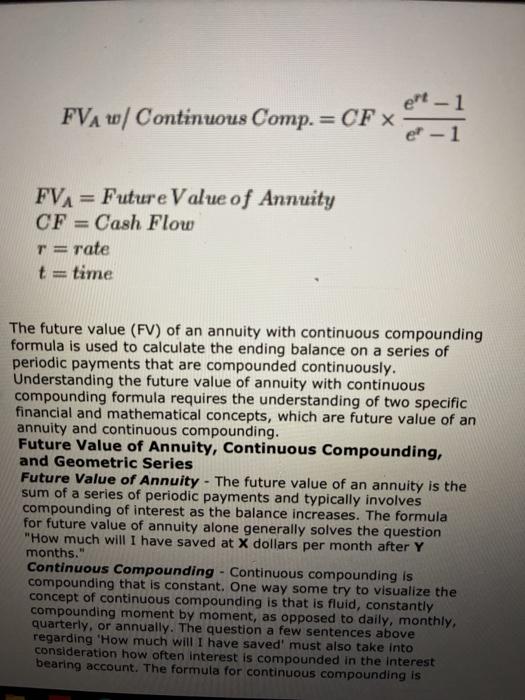
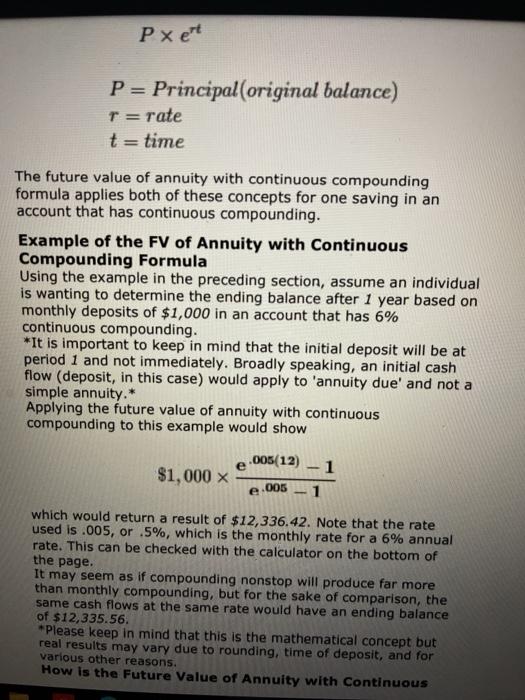
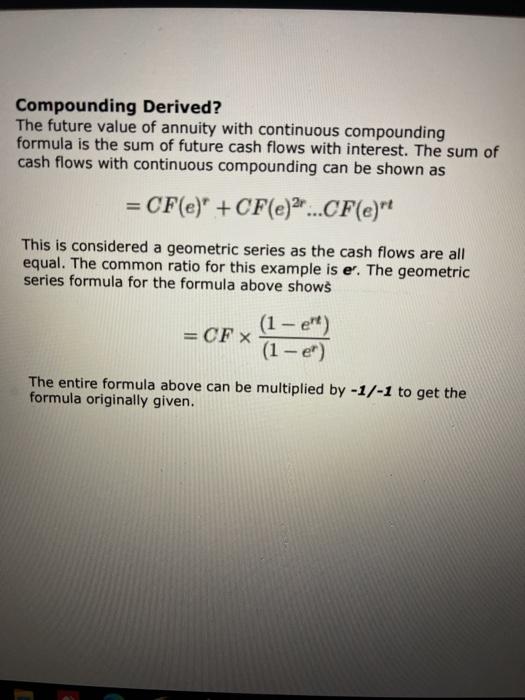
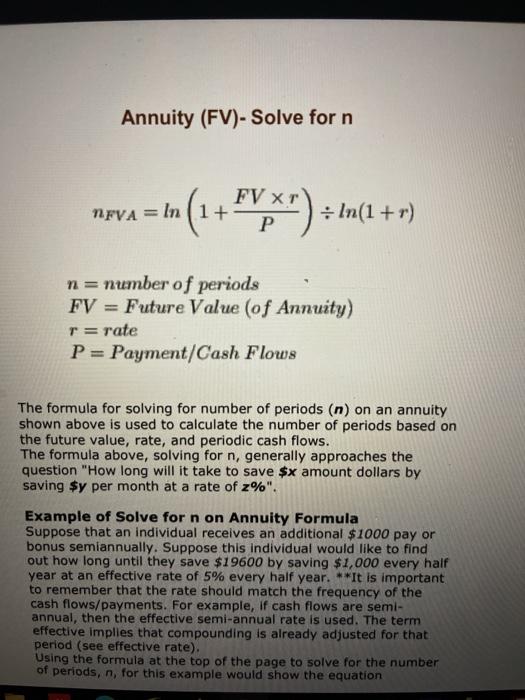
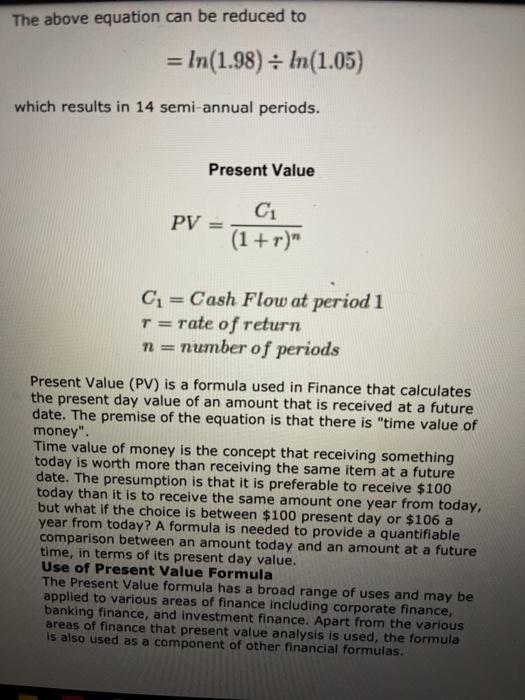
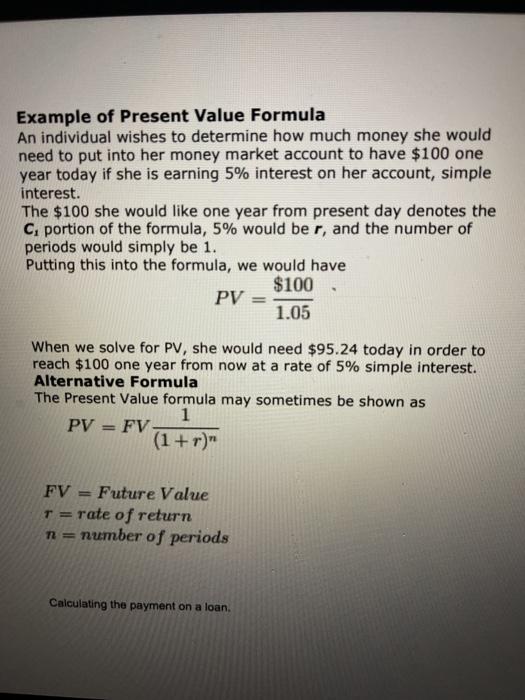
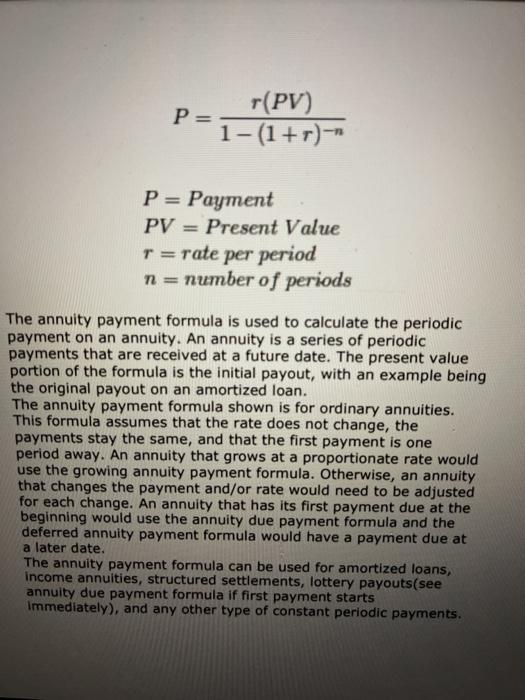
Need the answer in Java Language!!!
Programming Project-3 In this project you will write a program that perform certain financial calculations. The financial calculations should be done in methods. Do sections A B and C in one program Section A With the below inputs compute and display the future value of an annuity and the future value with continuous compounding. Also display the difference in the future value with continuous compounding and the future value. Your program should 1. Use loops to generate the values of each row below. 2. Use methods to calculate the Future Value and the future value with continuous compounding, 3. Your output should display your name and Student Number 4. Your output should show the table as follows or something close to this. Payment APR Years FV FV/Continuous FVIC - FV $500.00 $500.00 $500.00 $500.00 2 % 3 % 4 % 5 % on or on on $####.## $####.## $####.## $####.## $####.## $####.## $####.## $###### S###### $###### $###### S####.## P=$500.00 r=2 %, per year for 5 years. P=$500.00 3% . per year for 5 years. P=$500.00 24 %. per year for 5 years. P=$500.00 r=5 %. per year for 5 years. P=$500.00 r=6%. per year for 5 years. Pa$500.00 r=7% per year for 5 years. P=$500.00 -8% per year for 5 years. P-$500.00 r2 %. per year for 7 years. P=$500.00 r3%. per year for 7 years Pu$500.00 24%. per year for 7 years P=$500.00 r=5 %. per year for 7 years. P=$500.00 r=6 % , per year for 7 years. P=$500.00 r=7 % , per year for 7 years. P=$500.00 r=8 % . per year for 7 years. P=$500.00 r=2 %, per year for 10 years. P=$500.00 r=3 % , per year for 10 years. P=$500.00 r=4 % , per year for 10 years. P=$500.00 =5 %. per year for 10 years. P=$500.00 r=6 %. per year for 10 years. P=$500.00 r=7 %. per year for 10 years. P=$500.00 r=8 %. per year for 10 years. P=$1000.00 r=2 %, per year for 5 years. P=$1000.00 =3 % . per year for 5 years. p=$1000.00 -4% , per year for 5 years. P=$1000.00 =5 % . per year for 5 years. P=$1000.00 r=6 % . per year for 5 years. P=$1000.00 r=7%. per year for 5 years. P=$1000.00 r=8 %. per year for 5 years. P=$1000.00 r=2 %, per year for 7 years. P=$1000.00 -3% . per year for 7 years. Pu$1000.00 -4% , per year for 7 years, Pa$1000.00 =5%. per year for 7 years. P=$1000.00 -6%. per year for 7 years. Pa$1000.00 r7 % . per year for 7 years. P $1000.00 -8% . per year for 7 years. P-S1000.00 -2%. per year for 10 years P=$1000.00 r=3%, per year for 10 years. P=$1000.00 r=4 % . per year for 10 years. P=$1000.00 r=5 % , per year for 10 years. P=$1000.00 r=6 % , per year for 10 years. P=$1000.00 r=7 %. per year for 10 years. P=$1000.00 r=8 %. per year for 10 years. P=$1500.00 r=2 %, per year for 5 years. P=$1500.00 r=3 % , per year for 5 years. P=$1500.00 r=4 %. per year for 5 years. P=$1500.00 r=5 % . per year for 5 years. P=$1500.00=6 %. per year for 5 years. P=$1500.00 r=7%. per year for 5 years. P=$1500.00 r=8 %. per year for 5 years. P=$1500.00 r=2 %, per year for 7 years. P=$1500.00 r=3 % . per year for 7 years. P=$1500.00 -4 % . per year for 7 years. P=$1500.00 -5%, per year for 7 years. P=$1500.00 r=6% per year for 7 years. P=$1500.00 -7% per year for 7 years. P=$1500.00 -8% . per year for 7 years. P=$1500.00 -2%. per year for 10 years. P=$1500.00 r=3 % , per year for 10 years. P=$1500.00 4 % . per year for 10 years. P=$1500.00 r=5% . per year for 10 years. P-$1500.00 6% per year for 10 years. P=$1500.00 -7%. per year for 10 years 4 / 14 75% + P=$1500.00 r=8 %. per year for 10 years. Section B Next the program should compute the periods necessary to achieve a given future value (FV) for a given interest rate. See section on Annuity (FV)- Solve for n. 1. Use loops to generate the values of each row below. 2. Use methods to calculate the number of periods to achieve the future. 3. Your output should show the table as follows or something close to this. FV rate per period Periodic payment. Number of periods 5% 5% $1000.00 $1200.00 $1400.00 $1600.00 $1800.00 $2000.00 5% 5% 5% 5% $200.00 $200.00 $200.00 $200.00 $200.00 $200.00 ### FV=$1000.00 r=2% P=$200 Semi-annually FV=$1000.00 r=3% P=$200 Semi-annually FV=$1000.00 r=4% P=$200 Semi-annually FV=$1000.00 r=5% P=$200 Semi-annually FV=$1000.00 r=6% P=$200 Semi-annually FV=$1000.00 r=7% P=$200 Semi-annually FV=$1200.00 r=2% P-$200 Semi-annually FV=$1200.00 -3% P-$200 Semi-annually FV=$1200.00 -4% P-$200 Semi-annually FV=$1200.00 -5% P=$200 Semi-annually FV=$1200.00 -6% P=$200 Semi-annually FV=$1200.00 -7% P-$200 Semi-annually FV=$1400.00 -2% P-5200 Semi-annually FV=$1400.00 -3% Pu$200 Semi-annually FV-51400.00 -4% Pa$200 Semi-annually FV=$1400.00 r=5% P=$200 Semi-annually FV=$1400.00 r=6% P=$200 Semi-annually FV=$1400.00 r=7% P=$200 Semi-annually FV=$1600.00 r=2% P=$200 Semi-annually FV=$1600.00 r=3% P=$200 Semi-annually FV=$1600.00 r=4% P=$200 Semi-annually FV=$1600.00 r=5% P=$200 Semi-annually FV=$1600.00 r=6% P=$200 Semi-annually FV=$1600.00 r=7% P=$200 Semi-annually FV=$1800.00 r=2% P=$200 Semi-annually FV=$1800.00 r=3% P=$200 Semi-annually FV=$1800.00 -4% P=$200 Semi-annually FV=$1800.00 r=5% P=$200 Semi-annually FV=$1800.00 r=6% P=$200 Semi-annually FV=$1800.00 r=7% P=$200 Semi-annually FV=$2000.00 r=2% P=$200 Semi-annually FV=$2000.00 -3% P=$200 Semi-annually FV=$2000.00 r=4% P=$200 Semi-annually FV=$2000.00 -5% P=$200 Semi-annually FV=$2000.00 -6% P=$200 Semi-annually FV=$2000.00 -7% P=$200 Semi-annually Section- Then next part of the program should compute present values (PV). See the section "Present Value' below for the formula C1=100 -3% n=1 C1=100 -4% n=1 C1=100 =5% n=1 C1=100 r=6% n=1 C1=100 =3% n=2 C1=100 r=4% n=2 C1=100 r=5% n=2 C1=100 r=6% n=2 C1=100 =3% n=3 C1=100 =4% n=3 C1=100 =5% n=3 C1=100 r=6% n=3 C1=100 =3% n=3 C1=100 r=4% n=3 C1=100 =5% n=3 C1=100 r=6% n=3 1. Use loops to generate the values of each row below. 2. Use methods to calculate the present value for each row. 3. Your output should show the table as follows or something close to this. C1 rate per period Number of periods Present Value 1 1 $100.00 $100.00 $100.00 $100.00 $100.00 $100.00 3% 4% 5% 6% 3% 4% 1 $###### $#*##.## $####.## $###### $####.## $###### NN Formulas and Examples. (1+ FV of Annuity P P = Periodic Payment T=rate per period n = number of periods The future value of an annuity formula is used to calculate what the value at a future date would be for a series of periodic payments. The future value of an annuity formula assumes that 1. The rate does not change 2. The first payment is one period away 3. The periodic payment does not change If the rate or periodic payment does change, then the sum of the future value of each individual cash flow would need to be calculated to determine the future value of the annuity. If the first cash flow, or payment, is made immediately, the future value of annuity due formula would be used. Example of Future Value of an Annuity Formula An example of the future value of an annuity formula would be an individual who decides to save by depositing $1000 into an account per year for 5 years. The first deposit would occur at the end of the first year. If a deposit was made immediately, then the future value of annuity due formula would be used. The effective annual rate on the account is 2%. If she would like to determine the balance after 5 years, she would apply the future value of an annuity formula to get the following equation (1 +.02) - 1 $1000 .02 The balance after the 5th year would be $5204.04. A variation of the future Value calculation is the future value with continuous cash flow, see formula below. et - 1 FVA w/Continuous Comp. = CFX er - 1 FVA = Future Value of Annuity CF = Cash Flow r=rate t=time The future value (FV) of an annuity with continuous compounding formula is used to calculate the ending balance on a series of periodic payments that are compounded continuously. Understanding the future value of annuity with continuous compounding formula requires the understanding of two specific financial and mathematical concepts, which are future value of an annuity and continuous compounding. Future Value of Annuity, Continuous Compounding, and Geometric Series Future Value of Annuity - The future value of an annuity is the sum of a series of periodic payments and typically involves compounding of interest as the balance increases. The formula for future value of annuity alone generally solves the question "How much will I have saved at X dollars per month after Y months." Continuous Compounding - Continuous compounding is compounding that is constant. One way some try to visualize the concept of continuous compounding is that is fluid, constantly compounding moment by moment, as opposed to daily, monthly, quarterly, or annually. The question a few sentences above regarding "How much will I have saved' must also take into consideration how often interest is compounded in the interest bearing account. The formula for continuous compounding is Pxet P= Principal (original balance) r=rate t=time The future value of annuity with continuous compounding formula applies both of these concepts for one saving in an account that has continuous compounding. Example of the FV of Annuity with Continuous Compounding Formula Using the example in the preceding section, assume an individual is wanting to determine the ending balance after 1 year based on monthly deposits of $1,000 in an account that has 6% continuous compounding. *It is important to keep in mind that the initial deposit will be at period 1 and not immediately. Broadly speaking, an initial cash flow (deposit, in this case) would apply to 'annuity due' and not a simple annuity. Applying the future value of annuity with continuous compounding to this example would show .005(12) e 1 $1,000 005 -1 which would return a result of $12,336.42. Note that the rate used is .005, or .5%, which is the monthly rate for a 6% annual rate. This can be checked with the calculator on the bottom of the page. It may seem as if compounding nonstop will produce far more than monthly compounding, but for the sake of comparison, the same cash flows at the same rate would have an ending balance of $12,335.56. *Please keep in mind that this is the mathematical concept but real results may vary due to rounding, time of deposit, and for various other reasons. How is the Future Value of Annuity with Continuous Compounding Derived? The future value of annuity with continuous compounding formula is the sum of future cash flows with interest. The sum of cash flows with continuous compounding can be shown as = CF(e)" + CF(e)2...CF(e)" This is considered a geometric series as the cash flows are all equal. The common ratio for this example is er. The geometric series formula for the formula above shows (1 -e't) = CF (1 - e") The entire formula above can be multiplied by -1/-1 to get the formula originally given. Annuity (FV)- Solve for n NFVA = In (1+ = (1+ "VX") = n(1 +r) n = number of periods FV = Future Value (of Annuity) r=rate P= Payment/Cash Flows The formula for solving for number of periods (n) on an annuity shown above is used to calculate the number of periods based on the future value, rate, and periodic cash flows. The formula above, solving for n, generally approaches the question "How long will it take to save $x amount dollars by saving $y per month at a rate of z%". Example of Solve for n on Annuity Formula Suppose that an individual receives an additional $1000 pay or bonus semiannually. Suppose this individual would like to find out how long until they save $19600 by saving $1,000 every half year at an effective rate of 5% every half year. **It is important to remember that the rate should match the frequency of the cash flows/payments. For example, if cash flows are semi- annual, then the effective semi-annual rate is used. The term effective implies that compounding is already adjusted for that period (see effective rate). Using the formula at the top of the page to solve for the number of periods, n, for this example would show the equation The above equation can be reduced to = In(1.98) In(1.05) which results in 14 semi-annual periods. Present Value C PV = (1 + r)" C1=Cash Flow at period 1 r=rate of return n = number of periods Present Value (PV) is a formula used in Finance that calculates the present day value of an amount that is received at a future date. The premise of the equation is that there is "time value of money". Time value of money is the concept that receiving something today is worth more than receiving the same item at a future date. The presumption is that it is preferable to receive $100 today than it is to receive the same amount one year from today, but what if the choice is between $100 present day or $106 a year from today? A formula is needed to provide a quantifiable comparison between an amount today and an amount at a future time, in terms of its present day value. Use of Present Value Formula The Present Value formula has a broad range of uses and may be applied to various areas of finance including corporate finance, banking finance, and investment finance. Apart from the various areas of finance that present value analysis is used, the formula is also used as a component of other financial formulas. Example of Present Value Formula An individual wishes to determine how much money she would need to put into her money market account to have $100 one year today if she is earning 5% interest on her account, simple interest. The $100 she would like one year from present day denotes the C. portion of the formula, 5% would be r, and the number of periods would simply be 1. Putting this into the formula, we would have $100 PV 1.05 When we solve for PV, she would need $95.24 today in order to reach $100 one year from now at a rate of 5% simple interest. Alternative Formula The Present Value formula may sometimes be shown as 1 PV = FV (1 + r)" FV Future Value r = rate of return number of periods 12 = Calculating the payment on a loan. P=1-(1+5)* r(PV) P= Payment PV = Present Value r=rate per period n = number of periods The annuity payment formula is used to calculate the periodic payment on an annuity. An annuity is a series of periodic payments that are received at a future date. The present value portion of the formula is the initial payout, with an example being the original payout on an amortized loan. The annuity payment formula shown is for ordinary annuities. This formula assumes that the rate does not change, the payments stay the same, and that the first payment is one period away. An annuity that grows at a proportionate rate would use the growing annuity payment formula. Otherwise, an annuity that changes the payment and/or rate would need to be adjusted for each change. An annuity that has its first payment due at the beginning would use the annuity due payment formula and the deferred annuity payment formula would have a payment due at a later date The annuity payment formula can be used for amortized loans, income annuities, structured settlements, lottery payouts(see annuity due payment formula if first payment starts Immediately), and any other type of constant periodic payments. Programming Project-3 In this project you will write a program that perform certain financial calculations. The financial calculations should be done in methods. Do sections A B and C in one program Section A With the below inputs compute and display the future value of an annuity and the future value with continuous compounding. Also display the difference in the future value with continuous compounding and the future value. Your program should 1. Use loops to generate the values of each row below. 2. Use methods to calculate the Future Value and the future value with continuous compounding, 3. Your output should display your name and Student Number 4. Your output should show the table as follows or something close to this. Payment APR Years FV FV/Continuous FVIC - FV $500.00 $500.00 $500.00 $500.00 2 % 3 % 4 % 5 % on or on on $####.## $####.## $####.## $####.## $####.## $####.## $####.## $###### S###### $###### $###### S####.## P=$500.00 r=2 %, per year for 5 years. P=$500.00 3% . per year for 5 years. P=$500.00 24 %. per year for 5 years. P=$500.00 r=5 %. per year for 5 years. P=$500.00 r=6%. per year for 5 years. Pa$500.00 r=7% per year for 5 years. P=$500.00 -8% per year for 5 years. P-$500.00 r2 %. per year for 7 years. P=$500.00 r3%. per year for 7 years Pu$500.00 24%. per year for 7 years P=$500.00 r=5 %. per year for 7 years. P=$500.00 r=6 % , per year for 7 years. P=$500.00 r=7 % , per year for 7 years. P=$500.00 r=8 % . per year for 7 years. P=$500.00 r=2 %, per year for 10 years. P=$500.00 r=3 % , per year for 10 years. P=$500.00 r=4 % , per year for 10 years. P=$500.00 =5 %. per year for 10 years. P=$500.00 r=6 %. per year for 10 years. P=$500.00 r=7 %. per year for 10 years. P=$500.00 r=8 %. per year for 10 years. P=$1000.00 r=2 %, per year for 5 years. P=$1000.00 =3 % . per year for 5 years. p=$1000.00 -4% , per year for 5 years. P=$1000.00 =5 % . per year for 5 years. P=$1000.00 r=6 % . per year for 5 years. P=$1000.00 r=7%. per year for 5 years. P=$1000.00 r=8 %. per year for 5 years. P=$1000.00 r=2 %, per year for 7 years. P=$1000.00 -3% . per year for 7 years. Pu$1000.00 -4% , per year for 7 years, Pa$1000.00 =5%. per year for 7 years. P=$1000.00 -6%. per year for 7 years. Pa$1000.00 r7 % . per year for 7 years. P $1000.00 -8% . per year for 7 years. P-S1000.00 -2%. per year for 10 years P=$1000.00 r=3%, per year for 10 years. P=$1000.00 r=4 % . per year for 10 years. P=$1000.00 r=5 % , per year for 10 years. P=$1000.00 r=6 % , per year for 10 years. P=$1000.00 r=7 %. per year for 10 years. P=$1000.00 r=8 %. per year for 10 years. P=$1500.00 r=2 %, per year for 5 years. P=$1500.00 r=3 % , per year for 5 years. P=$1500.00 r=4 %. per year for 5 years. P=$1500.00 r=5 % . per year for 5 years. P=$1500.00=6 %. per year for 5 years. P=$1500.00 r=7%. per year for 5 years. P=$1500.00 r=8 %. per year for 5 years. P=$1500.00 r=2 %, per year for 7 years. P=$1500.00 r=3 % . per year for 7 years. P=$1500.00 -4 % . per year for 7 years. P=$1500.00 -5%, per year for 7 years. P=$1500.00 r=6% per year for 7 years. P=$1500.00 -7% per year for 7 years. P=$1500.00 -8% . per year for 7 years. P=$1500.00 -2%. per year for 10 years. P=$1500.00 r=3 % , per year for 10 years. P=$1500.00 4 % . per year for 10 years. P=$1500.00 r=5% . per year for 10 years. P-$1500.00 6% per year for 10 years. P=$1500.00 -7%. per year for 10 years 4 / 14 75% + P=$1500.00 r=8 %. per year for 10 years. Section B Next the program should compute the periods necessary to achieve a given future value (FV) for a given interest rate. See section on Annuity (FV)- Solve for n. 1. Use loops to generate the values of each row below. 2. Use methods to calculate the number of periods to achieve the future. 3. Your output should show the table as follows or something close to this. FV rate per period Periodic payment. Number of periods 5% 5% $1000.00 $1200.00 $1400.00 $1600.00 $1800.00 $2000.00 5% 5% 5% 5% $200.00 $200.00 $200.00 $200.00 $200.00 $200.00 ### FV=$1000.00 r=2% P=$200 Semi-annually FV=$1000.00 r=3% P=$200 Semi-annually FV=$1000.00 r=4% P=$200 Semi-annually FV=$1000.00 r=5% P=$200 Semi-annually FV=$1000.00 r=6% P=$200 Semi-annually FV=$1000.00 r=7% P=$200 Semi-annually FV=$1200.00 r=2% P-$200 Semi-annually FV=$1200.00 -3% P-$200 Semi-annually FV=$1200.00 -4% P-$200 Semi-annually FV=$1200.00 -5% P=$200 Semi-annually FV=$1200.00 -6% P=$200 Semi-annually FV=$1200.00 -7% P-$200 Semi-annually FV=$1400.00 -2% P-5200 Semi-annually FV=$1400.00 -3% Pu$200 Semi-annually FV-51400.00 -4% Pa$200 Semi-annually FV=$1400.00 r=5% P=$200 Semi-annually FV=$1400.00 r=6% P=$200 Semi-annually FV=$1400.00 r=7% P=$200 Semi-annually FV=$1600.00 r=2% P=$200 Semi-annually FV=$1600.00 r=3% P=$200 Semi-annually FV=$1600.00 r=4% P=$200 Semi-annually FV=$1600.00 r=5% P=$200 Semi-annually FV=$1600.00 r=6% P=$200 Semi-annually FV=$1600.00 r=7% P=$200 Semi-annually FV=$1800.00 r=2% P=$200 Semi-annually FV=$1800.00 r=3% P=$200 Semi-annually FV=$1800.00 -4% P=$200 Semi-annually FV=$1800.00 r=5% P=$200 Semi-annually FV=$1800.00 r=6% P=$200 Semi-annually FV=$1800.00 r=7% P=$200 Semi-annually FV=$2000.00 r=2% P=$200 Semi-annually FV=$2000.00 -3% P=$200 Semi-annually FV=$2000.00 r=4% P=$200 Semi-annually FV=$2000.00 -5% P=$200 Semi-annually FV=$2000.00 -6% P=$200 Semi-annually FV=$2000.00 -7% P=$200 Semi-annually Section- Then next part of the program should compute present values (PV). See the section "Present Value' below for the formula C1=100 -3% n=1 C1=100 -4% n=1 C1=100 =5% n=1 C1=100 r=6% n=1 C1=100 =3% n=2 C1=100 r=4% n=2 C1=100 r=5% n=2 C1=100 r=6% n=2 C1=100 =3% n=3 C1=100 =4% n=3 C1=100 =5% n=3 C1=100 r=6% n=3 C1=100 =3% n=3 C1=100 r=4% n=3 C1=100 =5% n=3 C1=100 r=6% n=3 1. Use loops to generate the values of each row below. 2. Use methods to calculate the present value for each row. 3. Your output should show the table as follows or something close to this. C1 rate per period Number of periods Present Value 1 1 $100.00 $100.00 $100.00 $100.00 $100.00 $100.00 3% 4% 5% 6% 3% 4% 1 $###### $#*##.## $####.## $###### $####.## $###### NN Formulas and Examples. (1+ FV of Annuity P P = Periodic Payment T=rate per period n = number of periods The future value of an annuity formula is used to calculate what the value at a future date would be for a series of periodic payments. The future value of an annuity formula assumes that 1. The rate does not change 2. The first payment is one period away 3. The periodic payment does not change If the rate or periodic payment does change, then the sum of the future value of each individual cash flow would need to be calculated to determine the future value of the annuity. If the first cash flow, or payment, is made immediately, the future value of annuity due formula would be used. Example of Future Value of an Annuity Formula An example of the future value of an annuity formula would be an individual who decides to save by depositing $1000 into an account per year for 5 years. The first deposit would occur at the end of the first year. If a deposit was made immediately, then the future value of annuity due formula would be used. The effective annual rate on the account is 2%. If she would like to determine the balance after 5 years, she would apply the future value of an annuity formula to get the following equation (1 +.02) - 1 $1000 .02 The balance after the 5th year would be $5204.04. A variation of the future Value calculation is the future value with continuous cash flow, see formula below. et - 1 FVA w/Continuous Comp. = CFX er - 1 FVA = Future Value of Annuity CF = Cash Flow r=rate t=time The future value (FV) of an annuity with continuous compounding formula is used to calculate the ending balance on a series of periodic payments that are compounded continuously. Understanding the future value of annuity with continuous compounding formula requires the understanding of two specific financial and mathematical concepts, which are future value of an annuity and continuous compounding. Future Value of Annuity, Continuous Compounding, and Geometric Series Future Value of Annuity - The future value of an annuity is the sum of a series of periodic payments and typically involves compounding of interest as the balance increases. The formula for future value of annuity alone generally solves the question "How much will I have saved at X dollars per month after Y months." Continuous Compounding - Continuous compounding is compounding that is constant. One way some try to visualize the concept of continuous compounding is that is fluid, constantly compounding moment by moment, as opposed to daily, monthly, quarterly, or annually. The question a few sentences above regarding "How much will I have saved' must also take into consideration how often interest is compounded in the interest bearing account. The formula for continuous compounding is Pxet P= Principal (original balance) r=rate t=time The future value of annuity with continuous compounding formula applies both of these concepts for one saving in an account that has continuous compounding. Example of the FV of Annuity with Continuous Compounding Formula Using the example in the preceding section, assume an individual is wanting to determine the ending balance after 1 year based on monthly deposits of $1,000 in an account that has 6% continuous compounding. *It is important to keep in mind that the initial deposit will be at period 1 and not immediately. Broadly speaking, an initial cash flow (deposit, in this case) would apply to 'annuity due' and not a simple annuity. Applying the future value of annuity with continuous compounding to this example would show .005(12) e 1 $1,000 005 -1 which would return a result of $12,336.42. Note that the rate used is .005, or .5%, which is the monthly rate for a 6% annual rate. This can be checked with the calculator on the bottom of the page. It may seem as if compounding nonstop will produce far more than monthly compounding, but for the sake of comparison, the same cash flows at the same rate would have an ending balance of $12,335.56. *Please keep in mind that this is the mathematical concept but real results may vary due to rounding, time of deposit, and for various other reasons. How is the Future Value of Annuity with Continuous Compounding Derived? The future value of annuity with continuous compounding formula is the sum of future cash flows with interest. The sum of cash flows with continuous compounding can be shown as = CF(e)" + CF(e)2...CF(e)" This is considered a geometric series as the cash flows are all equal. The common ratio for this example is er. The geometric series formula for the formula above shows (1 -e't) = CF (1 - e") The entire formula above can be multiplied by -1/-1 to get the formula originally given. Annuity (FV)- Solve for n NFVA = In (1+ = (1+ "VX") = n(1 +r) n = number of periods FV = Future Value (of Annuity) r=rate P= Payment/Cash Flows The formula for solving for number of periods (n) on an annuity shown above is used to calculate the number of periods based on the future value, rate, and periodic cash flows. The formula above, solving for n, generally approaches the question "How long will it take to save $x amount dollars by saving $y per month at a rate of z%". Example of Solve for n on Annuity Formula Suppose that an individual receives an additional $1000 pay or bonus semiannually. Suppose this individual would like to find out how long until they save $19600 by saving $1,000 every half year at an effective rate of 5% every half year. **It is important to remember that the rate should match the frequency of the cash flows/payments. For example, if cash flows are semi- annual, then the effective semi-annual rate is used. The term effective implies that compounding is already adjusted for that period (see effective rate). Using the formula at the top of the page to solve for the number of periods, n, for this example would show the equation The above equation can be reduced to = In(1.98) In(1.05) which results in 14 semi-annual periods. Present Value C PV = (1 + r)" C1=Cash Flow at period 1 r=rate of return n = number of periods Present Value (PV) is a formula used in Finance that calculates the present day value of an amount that is received at a future date. The premise of the equation is that there is "time value of money". Time value of money is the concept that receiving something today is worth more than receiving the same item at a future date. The presumption is that it is preferable to receive $100 today than it is to receive the same amount one year from today, but what if the choice is between $100 present day or $106 a year from today? A formula is needed to provide a quantifiable comparison between an amount today and an amount at a future time, in terms of its present day value. Use of Present Value Formula The Present Value formula has a broad range of uses and may be applied to various areas of finance including corporate finance, banking finance, and investment finance. Apart from the various areas of finance that present value analysis is used, the formula is also used as a component of other financial formulas. Example of Present Value Formula An individual wishes to determine how much money she would need to put into her money market account to have $100 one year today if she is earning 5% interest on her account, simple interest. The $100 she would like one year from present day denotes the C. portion of the formula, 5% would be r, and the number of periods would simply be 1. Putting this into the formula, we would have $100 PV 1.05 When we solve for PV, she would need $95.24 today in order to reach $100 one year from now at a rate of 5% simple interest. Alternative Formula The Present Value formula may sometimes be shown as 1 PV = FV (1 + r)" FV Future Value r = rate of return number of periods 12 = Calculating the payment on a loan. P=1-(1+5)* r(PV) P= Payment PV = Present Value r=rate per period n = number of periods The annuity payment formula is used to calculate the periodic payment on an annuity. An annuity is a series of periodic payments that are received at a future date. The present value portion of the formula is the initial payout, with an example being the original payout on an amortized loan. The annuity payment formula shown is for ordinary annuities. This formula assumes that the rate does not change, the payments stay the same, and that the first payment is one period away. An annuity that grows at a proportionate rate would use the growing annuity payment formula. Otherwise, an annuity that changes the payment and/or rate would need to be adjusted for each change. An annuity that has its first payment due at the beginning would use the annuity due payment formula and the deferred annuity payment formula would have a payment due at a later date The annuity payment formula can be used for amortized loans, income annuities, structured settlements, lottery payouts(see annuity due payment formula if first payment starts Immediately), and any other type of constant periodic payments Step by Step Solution
There are 3 Steps involved in it
Step: 1

Get Instant Access to Expert-Tailored Solutions
See step-by-step solutions with expert insights and AI powered tools for academic success
Step: 2

Step: 3

Ace Your Homework with AI
Get the answers you need in no time with our AI-driven, step-by-step assistance
Get Started


